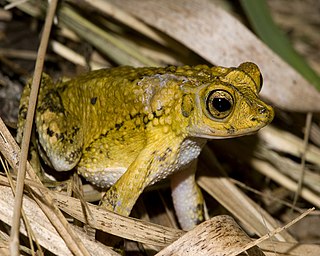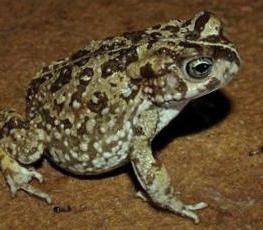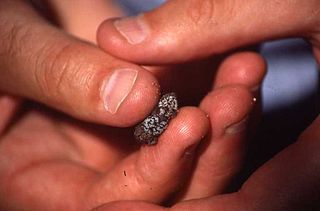
Nectophryne, or African tree toads, is a small genus of true toads with only two species. They are native to West and Central Africa: Nigeria, Cameroon, Gabon, northeastern Congo, Bioko and Equatorial Guinea. Nectophryne afra uses small bodies of water to lay its eggs which are then guarded by the male.

The Puerto Rican crested toad, or simply Puerto Rican toad, is a species of toad found only in Puerto Rico and the Virgin Islands. It is the only species of toad native to Puerto Rico and the Virgin Islands. The species formerly occurred in Virgin Gorda and along the southern and northern karst in Puerto Rico. It is listed as a threatened by the US Fish and Wildlife Service due to habitat loss and introduced species. At one period of time it was believed to be extinct until it was rediscovered in 1966. The IUCN has the species listed as endangered.

Hurter's spadefoot toad or Hurter's spadefoot is a species of American spadefoot toad found in the south central United States ; its range might extend to the adjacent northern Mexico. It was once classified as a subspecies of the eastern spadefoot toad, but it has been granted its own species status. The specific name hurterii is in honor of the Swiss-American naturalist and curator of the St. Louis Academy of Sciences, Julius Hurter.

The wildlife of South Africa consists of the flora and fauna of this country in southern Africa. The country has a range of different habitat types and an ecologically rich and diverse wildlife, vascular plants being particularly abundant, many of them endemic to the country. There are few forested areas, much savanna grassland, semi-arid Karoo vegetation and the fynbos of the Cape Floristic Region. Famed for its national parks and big game, 297 species of mammal have been recorded in South Africa, as well as 849 species of bird and over 20,000 species of vascular plants.

The sand toad, Cape sand toad, common Cape toad, or narrow-headed toad is a species of toad in the family Bufonidae. It is endemic to South Africa and found in southwestern and southern part of Western Cape Province to extreme southwestern Eastern Cape Province, from Nieuwoudtville in the west to Humansdorp in the east, along the coastal flats and Cape Fold Mountains from the sea level to 1,500 m (4,900 ft) asl.

Rhinella atacamensis, sometimes called the Vallenar toad or Atacama toad, is a species of toad in the family Bufonidae. It is endemic to Chile and occurs between Paposo and Las Chilcas. It inhabits the desert Pacific coastal region with Mediterranean influences and is found in and near oases and streams. Breeding takes place in permanent pools, streams, and rivers. While abundant at a few sites, it has declined overall and gone locally extinct at some sites. Threats to this species include extensive droughts and water pollution as well as extraction of surface water, mining, agriculture, livestock farming, and timber plantations.

Incilius bocourti is a species of toad in the family Bufonidae. It is found in southwestern Guatemala and in Chiapas in the adjacent Mexico. Its phylogenetic position is uncertain; it might not to belong to this genus, being the sister taxon of Anaxyrus instead. It is named after Marie Firmin Bocourt, a French zoologist and artist.
Poyntonophrynus dombensis is a species of toad in the family Bufonidae. It is found in southwestern Angola and northwestern Namibia.
Poyntonophrynus grandisonae is a species of toad in the family Bufonidae. It is endemic to Namibe Province, Angola. Its range may be more widespread than currently known, including the nearby Iona National Park. It is only known from a few specimens because there has not been much research in the surrounding area, and thus its 2014 IUCN Red List of Threatened Species assessment remained at "Data Deficient".
The Inyanga toad or Inyangani toad is a species of toad in the family Bufonidae. It is known from the Inyanga Mountains of eastern Zimbabwe at elevations of 2,400–2,560 m (7,870–8,400 ft) asl; it is expected to occur in the adjacent Mozambique but has not been recorded there, probably because of lack of surveys. Originally described as a subspecies of Bufo gariepensis, most recent treatments have treated it as a full species.
Mertensophryne lindneri is a species of toad in the family Bufonidae. It is found on the coastal lowlands of eastern Tanzania and northern Mozambique to southeastern Malawi, up to 650 m (2,130 ft) asl. Its habitats are woodlands, thickets, dry forests, farmland, and even rocky outcrops; it tolerates low-intensity cultivation. Its breeding habitat is unknown but presumably includes ponds or streams. It is considered uncommon but also difficult to observe, typically found after heavy rain. The intensification of agriculture and expanding human settlements are considered likely threats to it.
The paradise toad is a species of toad in the family Bufonidae found in Richtersveld, Bushmanland and Namaqualand regions in western South Africa and adjacent Namibia.
Mertensophryne taitana is a species of toad in the family Bufonidae. It is found in southeastern Kenya and southward through Tanzania to southeastern Democratic Republic of the Congo, northern Zambia, Malawi, and adjacent Mozambique. Its natural habitats are sandy places in woodlands, grasslands, open savanna, and agricultural fields. It is an opportunistic breeder utilizing small, temporary pools, and apparently, streams. The tadpole develop very fast, reaching metamorphosis in only 13 days. This adaptable species is not believed to face any significant threats.

Poyntonophrynus vertebralis is a species of toad in the family Bufonidae. It is found in South Africa, Lesotho, and possibly Botswana and southeastern Zimbabwe. It has many common names: pigmy toad, pygmy toad, flat toad, African dwarf toad, and southern pygmy toad.

Mertensophryne is a genus of true toads. They are found in eastern and southern Democratic Republic of Congo to Kenya, Tanzania, Malawi, southeastern Zimbabwe, and adjacent Mozambique. Their common names include snouted frogs, Chirinda forest toads, and forest toads. The genus is named for Robert Mertens, German zoologist and herpetologist.

The African tree toad is a species of toad in the family Bufonidae. It is found in the West and Central Africa from southwestern Nigeria through Cameroon to Equatorial Guinea, Gabon, and northeastern Democratic Republic of the Congo.

Bates's tree toad is a species of toad in the family Bufonidae. It is recorded in an area running from southern Cameroon to south-western Gabon through south-western Central African Republic to north-eastern Democratic Republic of the Congo; it presumably occurs in Equatorial Guinea and Congo, and perhaps in Nigeria, but has not yet been recorded there. Its common and specific names commemorate George Latimer Bates (1863–1940), an American naturalist who traveled in West Africa.

Poyntonophrynus fenoulheti is a species of small toad found in southern Africa. It is known under many common names, including Fenoulhet's toad, Fenoulhet's pygmy toad, and northern pygmy toad. It grows to a maximum size of 43 mm.

Vandijkophrynus, also known as Van Dijk's toads, are a small genus of true toads, family Bufonidae. They are native to Southern Africa. The name commemorates Eddie Van Dijk, a South African herpetologist.












